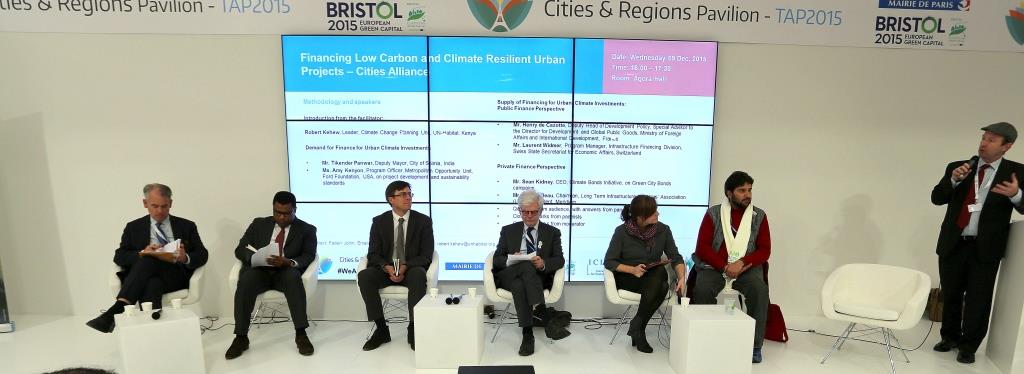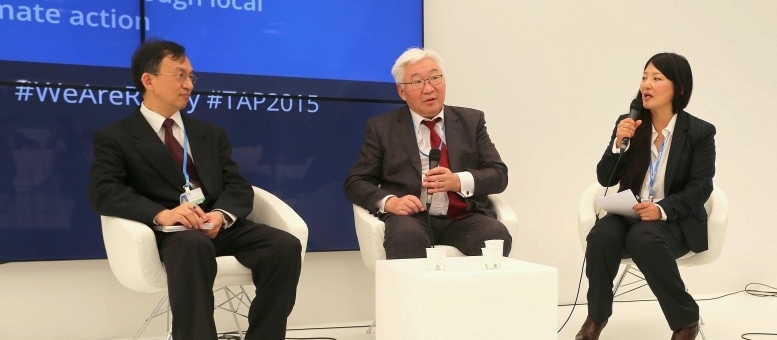Cities Alliance & UN-Habitat: Hurdling the Barriers to Deliver Climate Finance to Cities
Cities Alliance and UN-Habitat hosted a session at the Cities & Regions Pavilion on 9 December. Entitled “Low Carbon and Climate Resilient Urban Projects” and facilitated by Robert Kehew, Unit Leader, Climate Change Planning Unit, UN-Habitat, Kenya, the session looked at both the demand and supply sides of urban climate investment. While there is a general consensus on the need to invest in sustainable, resilient cities and an acknowledgement of the opportunity that this investment represents, much of the finance is not reaching the local level. This means that, as Amy Kenyon, Program Officer, Metropolitan Opportunity Unit, Ford Foundation, USA noted, local governments are still investing in business-as-usual projects with a short-term vision, like highways that bifurcate neighborhoods and are used mainly for transporting goods.

What are the barriers to the delivery of climate finance to cities? Sean Kidney, CEO of Climate Bonds Initiative stated that the world is “awash in capital” and that projects must be designed with small amounts of public funding, used only to leverage private investment. However, local governments must in turn design convincing, bankable projects and increase their creditworthiness to encourage large institutions to invest. As Kehew commented, it is necessary to “take need and turn it into demand”. Kenyon suggested that there are structural and capacity roadblocks, with cities lacking the personnel to develop and deliver large scale infrastructure projects. Coordination between different levels of government may also be lacking.
Panellists suggested a variety of options for overcoming these barriers. Henry de Cazotte, Deputy Head of Development Policy, Ministry of Foreign Affairs and International Development, France pointed out that, through the Agence Francaise de Developpement (AFD), France has shown that it is possible to take direct risks on behalf of municipalities, with loans to, for example, Dakar and Johannesburg for infrastructure projects. Raising local bonds is also a possibility, while panellists agreed that public private partnerships (PPPs) will play an ever larger role. Kidney argued that cities can overcome a lack of creditworthiness by bundling municipal projects and raising capital, as has been done successfully in Sweden – all countries should have such a cooperative bond raising facility for municipalities!
Thierry Déau, Founding Partner and Chief Executive Officer, Meridiam presented his company, whose business model is built exclusively on the equity financing of projects sponsored by public authorities for the benefit of the community. Déau explained that it was now part of the duty of investors to focus on sustainability, as climate change will affect the value of all future investments. Deau highlighted the importance of benchmarking for investors and regulators, in order to demonstrate that investments in sustainability projects produce better and more stable returns. On a similar note, Laurent Widmer, Program Manager, Infrastructure Financing Division, Swiss State Secretariat for Economic Affairs mentioned the role of standards, labels and awards such as the European Energy Award: an assessment tool and guideline for cities on integrating energy considerations into city planning. These help local governments integrate and prioritize, while increasing the visibility of leading cities to donors and financial institutions.
A number of panellists highlighted the need for intermediaries between cities and finance. These intermediaries, Kenyon said, must have no financial interest in the projects; they must also build long-term capacity and understand technical solutions. De Cazotte pointed to the Compact of Mayors as an example of international cooperation and wondered whether it would be possible for major cities united in such initiatives to create a financial institution to fund smaller cities with lower credit ratings.
Kehew also invited panellists to discuss the Transformative Actions Program (TAP), launched in 2015 to increase the visibility of ambitious climate actions in cities and regions. The first phase of the TAP collected over 120 projects from around the world. De Cazotte suggested that to improve the TAP, a platform is required to bring institutions into contact with cities (the strong mobilization of the demand-side is good, but more structured discussion with the supply-side will only strengthen it), while Kenyon stated that financial institutions must be involved at an early stage to avoid “locking in” the need for a specific form of finance.
Ultimately panellists were divided on the most important barriers to increased climate finance. Tikender Panwar, Deputy Mayor, City of Shimla, India insisted that there is a huge demand for climate finance at the local level and a small supply, and suggested that “crony capitalism” was an obstacle to delivery. Other panellists reiterated that cities needed more time and skills to develop viable projects and that leadership would play a vital role.





